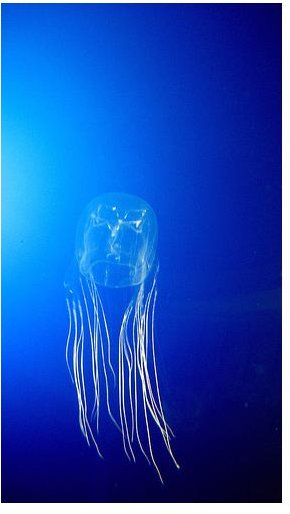Main Facts About Box Jellyfish and Their Adaptation and Habitat
Although some varieties of the box jellyfish are extremely venomous, these are relegated to the Indopacific ocean arena. The main facts about box jellyfish are that they are pale blue, pink, or colorless. They have a distinct set of evolved eyes, they have a distinctive four-sided bell with rudimentary eyes on each side, and they have no brain; only basic sensory perception.
Habitat
The most talked about box jellyfish is the Chironex fleckeri, which is native to the waters of Papua New Guinea, the Philippines, Northern Australia and Vietnam, although other box jellyfish live in the tropical waters just off the coast of most tropical land masses. They feed primarily on zooplankton, shrimp, small fishes, worms and other jellyfish.
Since they are relatively poor swimmers, they travel in and out with the tides and are often brought up near shore at high tide. Unfortunate individuals can get left behind when the tide goes and this is where they pose the highest threat to humans. Although they don’t use it often, the box jelly can propel itself though the water at speeds of up to four knots. This speed is used to avoid predators, but researchers are torn as to whether they use this technique to actively pursue prey. It would seem to be contradictory to the build of the animal so personally I side with those who see it as only a defense mechanism.
Box jellyfish are known to frequent river mouths and estuaries after a strong rain, which is perhaps because this stirs up smaller creatures and makes feeding easier. They are almost never found floating above sea grass or coral; this is most likely because these are perfect shelters for the natural predators of the jellyfish.
Unique Adaptation
Of their several unique adaptations, there are two that stand out: the evolved eyes and the cnidocytes on their long tentacles. The eyes of this particular jellyfish can do more than just sense the presence of light and dark. These evolved eyes contain retinas, corneas and lenses that allow them to not only sense points of light but to distinguish between colors as well.
Australian researchers isolated a single jellyfish in a clear tank and experimented by placing poles of different colors in the water with it. The jellyfish reacted favorably to darker colors, retreated from red and was completely unaware of white objects.
Most jellyfish have rudimentary nervous systems. The box jelly is slightly more advanced and has a central nerve ring around the base of its umbrella. This is used to coordinate the movement of the various tentacles and the velarium. The velarium is a special flap beneath the umbrella that concentrates the flow of water being expelled from the box jelly. This is how it can achieve short bursts of speed.
The sting of the box jellyfish is deadly to most of its prey. The nematocysts, which are harpoon-like darts that fire out of the cnidoblasts, deliver the venom and work whether the box jelly is alive or dead. This accounts for the warnings to watch out for dead jellyfish on the beach as it is a reaction to the chemicals on the skin of the prey and not a voluntary action that causes the release of the venom. These nematocysts continually pump venom into a victim until they are empty. If a victim tries to pull away from initial sting, the entire tentacle tenses causing greater contact with the skin and more stings.
Interesting Facts
- The box jelly fish isn’t a jellyfish at all; it is a Cubgoza.
- Box jellyfish are responsible for 5,567 recorded deaths since 1884, with a majority of those attributed to Chironex fleckeri.
- They are also known as sea wasps due to the ferocity of their sting.
- Box jellyfish have no gills or breathing organs. They obtain oxygen directly from the water through their extremely thin skin.
- They have no brains. Instead, they have a nerve net that responds to touch but because there is no higher thinking involved the reaction is always the same.
- They sleep on the ocean floor between three am and dawn to avoid predators.
- It propels itself forward in a jet-like motion and can reach speeds of three to four knots or up to six feet per second.
- A box jellyfish can have as many as 15 tentacles on each corner (although there are usually 8). These can be up to nine feet in length and contain as many as 5,000 nematocysts (stinger cells).
- They do not have a digestive system and absorb nutrients directly through the lining of the stomach. This means that they use their mouths not only to take food in but to expel the waste as well.
References
- Image: gautsch.net @ flickR, http://www.flickr.com/photos/of_guido/1285937237/sizes/m/in/photostream/
- “Box Jellyfish, Box Jellyfish Pictures, Box Jellyfish Facts - National Geographic.” Animals - Animal Pictures - Wild Animal Facts - Nat Geo Wild - National Geographic. Web. 25 Aug. 2011. http://animals.nationalgeographic.com/animals/invertebrates/box-jellyfish/
- Author unknown, “The Australian Box Jellyfish.” The Real Australian Outback - An Outback Australia Travel Guide. Web. 25 Aug. 2011. http://www.outback-australia-travel-secrets.com/box-jellyfish.html
- “Box Jellyfish. Dangers on the Great Barrier Reef.” Holiday, Cairns Accommodation, Port Douglas Cruises, Diving, Townsville Accommodation, Qld. Web. 25 Aug. 2011. http://www.barrierreefaustralia.com/the-great-barrier-reef/jellyfish.htm
